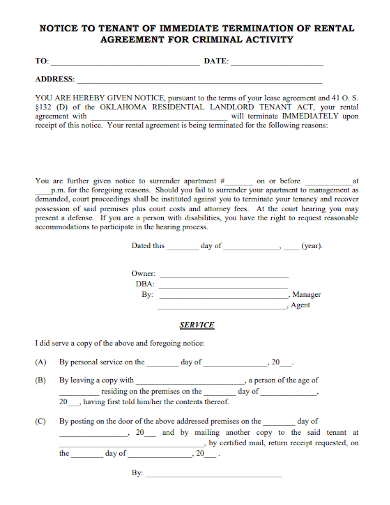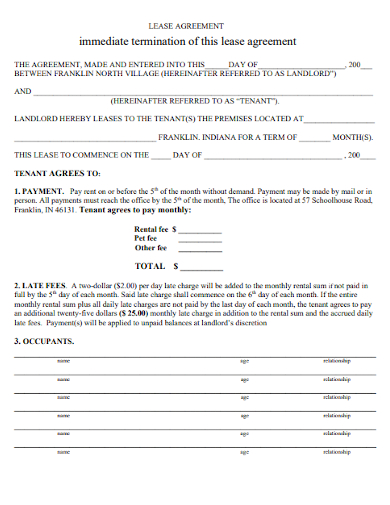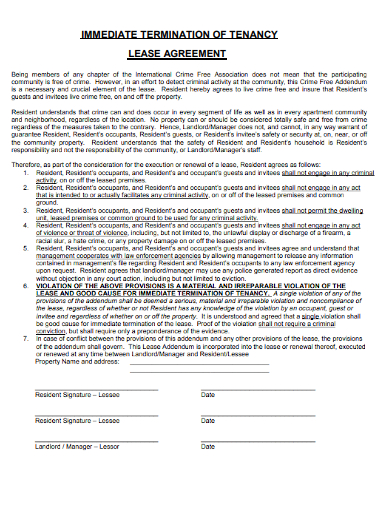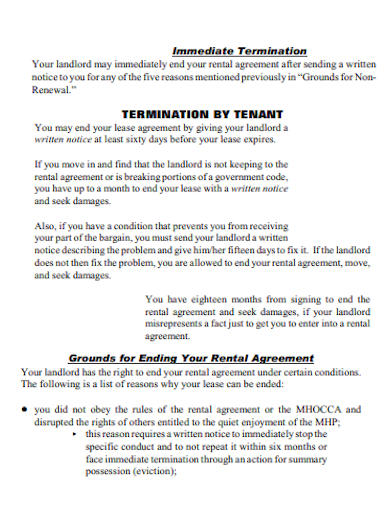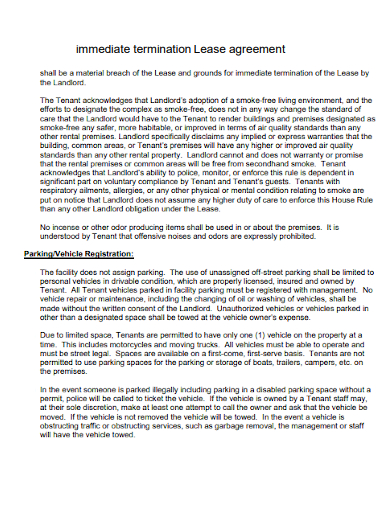A lease is a contract between two or more parties that binds them to the agreement’s conditions. A tenant may need to depart the rental unit early after signing a rental agreement or lease for a variety of reasons. Similarly, the landlord has the right to terminate the lease in certain circumstances. When giving notice of intent to terminate a lease, it’s critical to follow state regulations as well as the lease’s stipulations.
Because a lease is a contract, tenants are obligated to stay for the duration of the lease. This means they are liable for paying rent for the duration of the contract. There are certain exceptions to this regulation, especially if the landlord breaches or violates the lease. Some states give renters specific reasons to breach their leases, such as military duty or domestic abuse issues.
If a landlord violates the lease’s provisions, particularly health and safety regulations, the tenant may be permitted to move out without giving notice, or with less notice than is usually necessary. The legal phrase for this is “constructive eviction,” which means that the tenant is effectively removed from the property because the rental premises are unlivable. This may also be the situation if the renter is unable to stay in the rental property due to a natural disaster or major damage to the rental unit. The landlord, on the other hand, can sue the renter for damages if the tenant violates the lease without a legally justifiable basis.
If a tenant violates the conditions of the lease or breaks the law, the landlord has the legal right to terminate the lease. The tenant’s infraction must be serious, such as failing to pay rent on time or possessing a dog despite a rule against dogs on the premises. Violations of the law, such as selling drugs on the premises, are sufficient grounds for a landlord to terminate the lease.
The landlord must first send the tenant a termination notice that clearly states that the tenancy has ended. The terms of the notice, as well as the conditions for delivery, differ by state law. The tenant may be given additional time to correct the infringement, such as by paying past-due rent. Alternatively, the notice could specify that the renter must quit the premises immediately or face eviction.
This article will explore how to write a proper and effective termination of lease agreement. To begin, check out these immediate termination of lease agreement samples that we have listed for you down below. After getting yourself acquainted with the document, what it looks like, and how it generally works, feel free to use these samples as guides or even as templates once you start writing the document on your own.
6+ Immediate Termination of Lease Agreement Samples
1. Immediate Termination of Lease Agreement Template
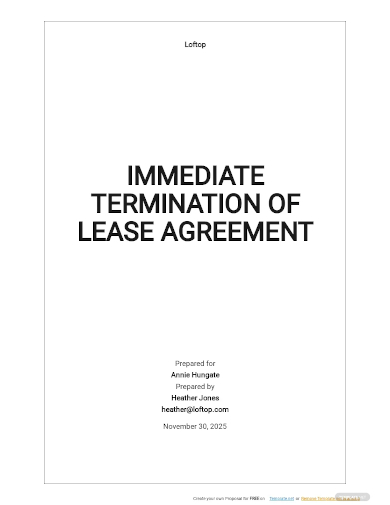
2. Immediate Termination of Rental Agreement by Landlord
3. Sample Immediate Termination of Lease Agreement
4. Immediate Termination of Tenancy Lease Agreement
5. Notice of Immediate Termination of Lease Agreement
6. Printable Immediate Termination of Lease Agreement
7. Basic Immediate Termination of Lease Agreement
What Is an Immediate Termination of Lease Agreement?
A Lease Termination Letter is used by both landlords and tenants to terminate a lease agreement early or to confirm that a lease term that is about to expire will not be renewed. This document can be completed and presented to the opposing side by either party in a leasing agreement. The majority of lease agreements require you to provide written notice within a specified number of days if you need to terminate your lease early. The use of a lease termination letter, even if your contract does not specifically demand it, may be beneficial to you in the event of a later disagreement. In order to avoid any misunderstandings about when the property will be unoccupied, a landlord or tenant will frequently present the other party with a lease termination letter at the conclusion of the lease period. When a property owner wants to sell or improve their property, or if they are dissatisfied with their current tenant, they may utilize a lease termination letter. Additionally, landlords can utilize this paper if they want to raise the rent and the current tenant does not wish to renew under the new terms.
Elements of an Immediate Termination of Lease Agreement
- Check the terms on the lease agreement
Before you begin the process of terminating your lease, have a look at the sort of rental agreement you have and the information contained inside it. In your Lease Agreement, you will find a list of the obligations and rights of both the landlord and the tenant. Here are some typical leases you may work with:- Standard Lease
- Month-to-Month Lease
- Sublease Agreement
- Name the parties involved
A landlord’s termination letter to a tenant must include the names and addresses of all of the persons engaged in the situation. First, make a note of the names of the landlord and the tenant, i.e., the person who owns the property and the party that is renting the property. - Reference the original rental agreement
Specify in this area of the form when the landlord and tenant signed the initial lease/rental agreement and when the lease will come to an end. - Fill the vacate date
Fill in the date on which the renter is expected to quit the premises. This date can be either (1) before the lease term’s expiration or (2) at the end of the lease term’s conclusion. - Reason for termination
The cause for termination is an important area of the letter, and it is where you explain why you want to discontinue your employment. Wrongful termination might result in legal consequences, thus it is advisable to offer a justification for your choice in your notice to avoid any confusion later. - Include a forwarding address
Make a note of where mail, future notices, and the security deposit should be forwarded. - Proof of service
If you are not the person who served the termination notice, you will be required to submit a signed Affidavit of Service. After signing the notice, it is handed over to the intended recipient, which could be either the landlord or the renter. This affidavit serves as proof that the notification was received on a specified date by the party in controversy.
Tips for Writing an Immediate Termination of Lease Letter
- Proofread
Please double-check the dates and spelling to ensure that the information is correct. - Keep it clear and concise
Include a detailed explanation for your decision to terminate your employment. For example, most contracts allow a tenant to vacate the premises early if the premises are uninhabitable and the landlord has failed to make the necessary improvements. - Check the lease for where and how to deliver your letter.
Leases frequently stipulate where you must give notice, and they may even specify how you must deliver your letter. - Don’t sit on it
Once you’ve determined that you need to cancel your lease early, you should draft and deliver your lease termination letter as quickly as possible to the landlord. Whenever feasible, it is preferable to give the other party as much warning as possible if you choose to terminate the agreement early.
FAQs
What is the difference between lease and rent?
The most significant distinction between a lease and a rental agreement is the length of time they are valid for. In most cases, a rental agreement is for a short length of time (typically 30 days), but a lease contract is for a longer amount of time (generally 12 months, although 6 and 18-month leases are also frequent).
What are the types of lease?
Leasing comes in a variety of forms, but the most popular are the absolute net lease, triple net lease, modified gross lease, and full-service lease, all of which are variations on the net lease. Before signing a lease agreement, tenants and business owners should thoroughly review the terms and conditions.
What are some disadvantages of leasing?
- Expensive in the long run
- Limited mileage
- High insurance cost
- Confusing
- Hard to cancel
- Requires good credit
- Lots of fees
- No customizations
When it comes to terminating a rental, it is necessary to examine your contract, local legislation, and the specifics of your situation. A local landlord-tenant attorney can help clarify your rights and guide you through the process of terminating a lease or rental agreement, which is the best method to get answers to any issues you may have.
Related Posts
FREE 10+ Environmental Risk Assessment Samples [ Health, Social, Impact ]
FREE 3+ Client Biopsychosocial Assessment Samples in PDF
FREE 10+ Event Risk Assessment Samples in PDF | MS Word
FREE 10+ Joint Assessment Samples [ Strategic, Risk, Needs ]
FREE 10+ Teleworker Self-Assessment Samples in PDF | DOC
FREE 10+ Market Assessment Samples in PDF | MS Word
FREE 10+ Quality Risk Assessment Samples [ Control, Assurance, Management ]
FREE 10+ Qualitative Risk Assessment Samples in PDF | DOC
FREE 10+ Comprehensive Needs Assessment Samples in PDF
FREE 10+ Evaluation Quality Assessment Samples [ Self, Loss, Data ]
FREE 10+ Promotion Assessment Samples [ Health, Self, Employee ]
FREE 10+ Environmental Impact Assessment Samples in PDF | DOC
FREE 10+ Employee Competency Assessment Samples in PDF | DOC
FREE 10+ Safety Assessment Samples [ Home, Health, Risk ]
FREE 10+ Change Impact Assessment Samples [ Management, Control, Request ]

